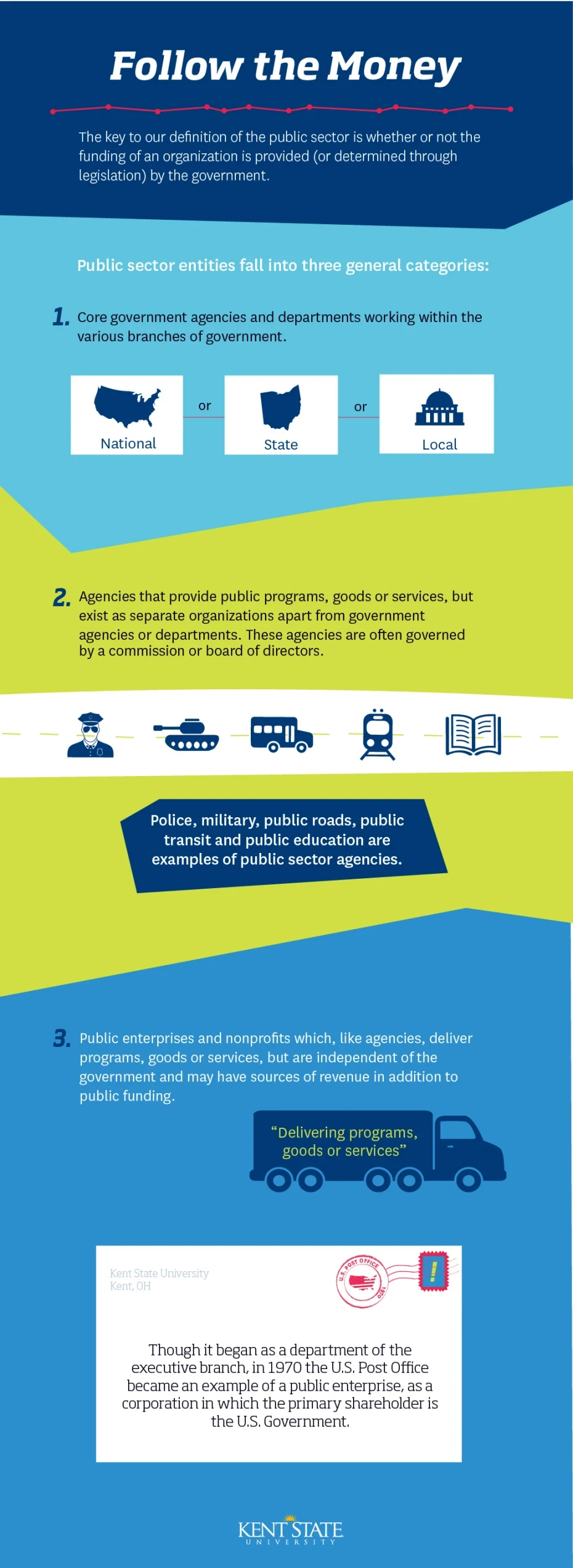In the world of public administration, there are frequent references to the “public sector.” But what exactly is the public sector? And why does it require such careful attention and monitoring by public officials? Broadly speaking, the public sector refers to any part of a state or national economy that is tied to public programs or services and is controlled by the government.
That encompasses a lot of critical elements—things that impact your everyday life and surrounding community—which is why it’s important to understand not only what comprises the public sector, but also who’s overseeing it, what decisions they’re making and how you can play an active role in shaping its output.
Follow the Money
The key to our definition of the public sector is whether or not the funding of an organization is provided (or determined through legislation) by the government. Public sector entities fall into three general categories:
Core government agencies and departments working within the executive, legislative or judicial branches of national, state or local government.
Agencies that provide public programs, goods or services, but exist as separate organizations apart from government agencies or departments. These agencies are often governed by a commission or board of directors. Police, military, public roads, public transit and public education are examples of public sector agencies.
Public enterprises and nonprofits which, like agencies, deliver programs, goods or services, but are independent of the government and may have sources of revenue in addition to public funding. Though it began as a department of the executive branch, in 1970 the U.S. Post Office became an example of a public enterprise, as a corporation in which the primary shareholder is the U.S. Government.
Providers of Critical Services…But Which?
As outlined above, agencies and organizations of the public sector are responsible for providing vital public services. In the United States, one can define public sector functions to include protection by police departments, fire departments and the military. They can also include social provisioning agencies, such as the Social Security Administration, Medicare and Medicaid.
Of course, public programs and services are not permanent, and what is available today may not always be. As the example of the U.S. Post Office illustrates, things change in the public sector. President Franklin D. Roosevelt’s New Deal programs operated largely within the public sector, but many of those programs have now been discontinued. Similarly, contemporary lawmakers have been working for many years to expand the U.S. public sector to include a public healthcare system.
Public Sectors Around the World
How we define the public sector in the U.S. is not necessarily applicable around the world.
In Europe and many Western nations, comprehensive health coverage and university education are classified as part of the public sector and are funded and/or overseen by government agencies. In communist or socialist countries like Venezuela or North Korea, a great many aspects of the economy fall within the public sector, as industries like broadcasting and even the food industry are state run.
Then there’s Sweden, which leads the world in public sector employment; 30 percent of the country’s employment is tied to the public sector, which oversees sectors like healthcare and liquor sales.1 By comparison, the public sector makes up less than 17 percent of the U.S. workforce and only six percent of that in Japan.2
What ought to qualify as “public sector” is generally understood to be those programs, goods and services that enhance the public good. Clearly, which programs and services meet that criteria is a matter of broad debate.
Contrasting Motivations for Public and Private Sectors
Because the private sector relies on its own ingenuity to provide goods and services, the profit motive spurs remarkable innovation and technological ingenuity. But what’s good for making a profit is not always beneficial for society.
Consider what might happen if fire departments were private sector businesses. Would you have the money to save your house if it went up in flames? If not, would your neighbors have the money to save their own homes when the fire spread? In the United States, we find these questions unconscionable because we believe in a public good that, while not always perfect, provides shared resources to all.
This is precisely why the public sector is so crucial. Profit-driven capital can lack compassion, and private sector businesses may feel no need to extend their goods or services to those who are challenged by poverty, age or illness. It is in everyone’s best interest that a fire on your block be put out before it spreads, that violence is subdued, and that children be educated so that they can perform their civic duty and find new ways to improve the standard of living for everyone.
The driving force behind this belief in the public good includes the public sector leaders who are responsible for identifying the best ways to leverage public funding in order to provide these services effectively and for all.
Given the opportunity, how might you influence the U.S. public sector? Would you attempt to broaden its offerings? Lobby for greater accessibility or redistribution of funding?
Explore the ways you could help drive the nation’s public future with the online Master of Public Administration from Kent State University, a program that can help equip you to become an effective leader of public service and nonprofits.
Sources:
- Retrieved on May 14, 2018, from sweden.se/society/20-things-to-know-before-moving-to-sweden/
- Retrieved on May 14, 2018, from forbes.com/sites/niallmccarthy/2017/07/21/scandinavia-leads-the-world-in-public-sector-employment-infographic/#5a0960371820





